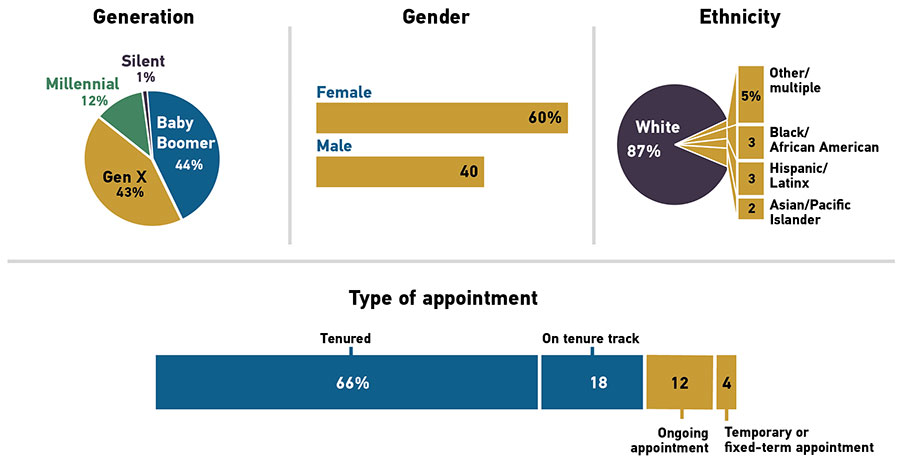Who Are Community College Faculty?
Among the 1,828 community college faculty who responded to our survey, a large majority (84%) are tenured or on the tenure track, with only 16% reporting they have ongoing or temporary/fixed-term appointments; 63% work full time. However, it's important to note that in this area our sample is not representative of the general community college faculty population. An analysis of federal data by the American Association of University Professors found that fewer than 20% of faculty jobs in AA institutions overall are tenure track and that more than 65% are part-time positions (15 percentage points higher than at other types of institutions). Among those who have full-time positions, the majority work on contracts. Part-time and fixed-term positions, as the analysis notes, are often the "least secure and worst remunerated teaching positions in higher education."1 All of these factors should be taken into account when considering our findings, as many of those who participated likely have more job security, benefits, and higher salaries than their non-tenure-track peers. For example, many contingent and part-time instructors are not supplied with a personal computer to do their work. Accessing support services and attending IT workshops and professional development can also be a challenge for those who must take on more courses and/or work multiple jobs to make ends meet. And at some institutions, part-time and fixed-term instructors are not eligible for the release time or stipends that can be granted for designing courses and learning new technologies.
When we examined the data by key demographic factors (figure 1), we found that most of our respondents were Baby Boomers (44%) and Gen Xers (43%); only 12% were Millennials. More than half of respondents identified as female (60%), which is only slightly higher than at other institution types.2 The majority of faculty in our sample identified as white (87%), followed by Hispanic/Latinx (3%), black (3%), and Asian (2%). Five percent identified as "other" or multiple ethnicities. Other national research also suggests that the proportion of white faculty members at community colleges is disproportionately high.3 In our research, white faculty were even more overrepresented, which might in part be explained by the fact that Midwestern community colleges have greater representation in our sample than those in US regions that are more ethnically diverse.4

Notes
-
American Association of University Professors, Data Snapshot.
↩︎ -
At institutions other than community colleges, 53% of faculty identified as female and 47% identified as male.
↩︎ -
Martin J. Finkelstein, Valerie Martin Conley, and Jack H. Schuster, "Taking the Measure of Faculty Diversity," Advancing Higher Education, April 2016, TIAA Institute.
↩︎ -
Forty-seven percent of community college faculty participants came from institutions in Minnesota. Other US regions represented include the Southeast at 19%, Rocky Mountains at 14%, Great Lakes at 6%, Mid-East at 6%, Far West at 4%, and the Southwest at 4%. There was no participation from community colleges in the New England states or in outlying areas/US territories.
↩︎